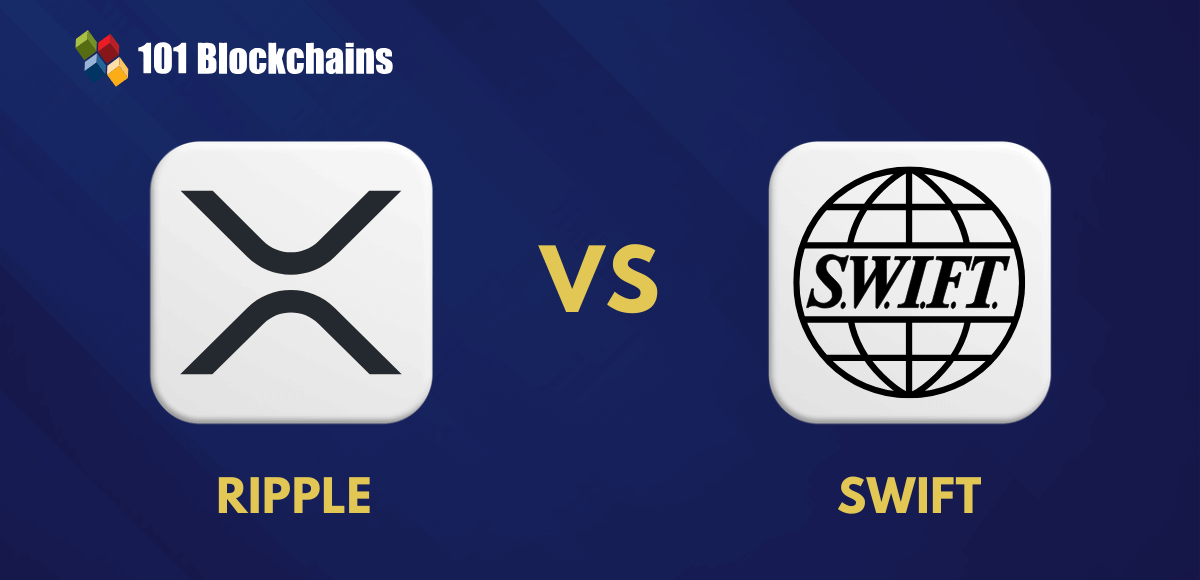Learn how blockchain truly works, master key definitions, and uncover what makes smart contracts so "smart." Dive into the fundamentals, gain valuable insights, and start your blockchain journey today!

- Comparisons
101 Blockchains
- on August 15, 2021
PoW Vs. PoS: A Comparison Between Two Blockchain Consensus Algorithms
Wondering how PoW and PoS are different from each other? Here you will find the detailed comparison between PoW and PoS i.e. PoW vs PoS.
The effectiveness of blockchain in ensuring decentralized and transparent transactions with reliable security is one of its biggest selling points. However, many would wonder about the possible mechanism which helps in verifying transactions before adding them to a blockchain network. This is where you would come across one of the integral aspects of a blockchain network’s operation i.e. consensus mechanism.
Subsequently, the Proof of Work vs Proof of Stake debate has also garnered substantial attention in recent times with emphasis on finding out a suitable consensus mechanism. The following discussion helps you understand Proof of Stake and Proof of Work, the two commonly implemented consensus algorithms. Most important of all, you can find a detailed overview of the differences between PoW and PoS algorithms.
Build your identity as a certified blockchain expert with 101 Blockchains’ Blockchain Certifications designed to provide enhanced career prospects.
Need for Consensus Algorithms
Blockchain transactions don’t involve any intermediaries, and all details of the transaction are updated on the digital distributed ledger. The nodes in the blockchain network have to take part in the validation process. The validation process would follow the norms outlined in a consensus algorithm. Since Proof of Work (PoW) and Proof of Stake (PoS) are two popular consensus algorithms in the world of blockchain, enterprises are troubled about selecting the best among them.
The final answer to proof of stake vs proof of work comparison is quite significant for defining effectiveness of solutions. Both of them are crucial for regulating the process of verifying transactions between users and adding them to public ledger. An in-depth understanding of the two consensus mechanisms and the differences between them could help you identify the suitable pick.
Understanding Proof of Work (PoW)
Before diving into a discussion on ‘Is proof of stake better?’ It is important to understand proof of work consensus. The term PoW gained recognition with the arrival of Bitcoin blockchain, which was the first notable implementation of the PoW consensus mechanism. Therefore, you could also find that PoW has been referred to as the original consensus mechanism on blockchain.
Proof of Work was touted as the most trustworthy approach for achieving blockchain consensus. It helped in achieving decentralization while excluding intermediaries and ensuring validity of transactions. On the contrary, growth in the size of the blockchain network could bring out the problems in this mechanism.
The next critical element in understanding proof of work for a PoW vs PoS comparison refers to working of PoW. The proof of work consensus mechanism requires miners to solve a cryptographic puzzle for validating a particular transaction. You could think of it as a race in which miners compete with each other for becoming the first in solving the puzzle.
Miners could solve the puzzle for generating the hash function for appending a block of transactions to the blockchain network. Miners could receive rewards for validating each transaction in the native cryptocurrency or token of the blockchain, alongside transaction fees. It is important to note that puzzles for PoW consensus are highly complex. Miners would need many complicated computational resources for solving the puzzles.
Understanding Proof of Stake (PoS)
The second entry in the proof of stake vs proof of work comparison would obviously bring PoS to the discussion. The problems associated with PoW consensus led to the need for reflecting on a potential alternative for achieving consensus. As a matter of fact, the PoS consensus algorithm improvises on the PoW algorithm for resolving the concerns of excessive dependence on energy consumption as a tool for determining the sequence of blockchain.
The proof of stake algorithm does not depend on computers competing with each other for generating the suitable hash. On the contrary, the PoS protocol focuses on determining participation according to ownership of the coin supply. Basically, proof of stake consensus replaces computational power with currency power. Therefore, the ability for validating transactions depends on the ‘stake’ of the user in the network.
The answer to ‘what is the difference between proof of stake and proof of work?’ depends considerably on understanding the working mechanism of PoS consensus. It is important to note that PoS systems don’t have any miners. On the other hand, the PoS protocol selects validators randomly according to their stake in the network. Validators don’t receive any type of reward for validating blocks and would get the transaction fees or network fees only. The validator takes on the responsibility of validating transactions in the block, signing them and proposing block for validation.
Not sure how to build your career in enterprise blockchains? Enroll Now – How to Build Your Career in Enterprise Blockchains
Proof of Work Vs Proof of Stake (PoW and PoS) – Key Differences
With a detailed understanding of proof of work and proof of stake consensus algorithms, it is possible to reflect on the differences between them. The comparison of PoW and PoS can help in finding a reliable answer to ‘Is proof of stake better?’ for developing efficient solutions for desired use cases.
Watch This Video To Know About POW vs POS – Key Differences Right Now!
-
Working
The first pointer for comparing proof of work and proof of stake algorithms would obviously refer to their working. Proof of Work is undoubtedly one of the oldest consensus algorithms. PoW involves bundling a group of transactions in a mempool, and miners have to verify validity of transactions by solving a cryptographic puzzle. So, ‘what is the difference between proof of stake and proof of work?’ when it comes to their working.
As compared to proof of work, the Proof of Stake or PoS algorithms do not rely on mathematical puzzles. On the contrary, the algorithm selects validators randomly according to their stake in the network. Proof of Stake algorithm does not involve the creation of any type of coin, especially with all coins created from the start.
-
Energy Use
The next critical factor for differentiating between PoW and PoS consensus algorithms refers to energy efficiency. Proof of Work consensus algorithms focuses on identifying the user who could modify the ledger by leveraging a competitive race. Participants in the race or miners have to use computational energy for proposing valid blocks that follow the network rules.
On the other side of the PoW vs PoS debate, Proof of Stake presents better scope for energy efficiency. However, PoW miners have the flexibility for using any type of energy sources such as wind, hydropower and other sustainable energy sources. PoS mechanisms would need specialized hardware and an active internet connection with heavy energy expenses.
-
Security
Among the many factors for deciding the better alternative between PoS and PoW, security would obviously take foremost priority. As a matter of fact, the answer to ‘Is proof of stake more secure than proof of work?’ could present a decisive impression. Before comparing PoW and PoS on the grounds of security, it is important to understand that PoS is comparatively new.
In the event of forking in PoW-based blockchain systems, miners must focus on the actual blockchain or shift to the new blockchain fork. Constant forking can present a formidable economic disadvantage, and proof of work consensus discourages constant forking.
On the other hand, Proof of Stake consensus does not impose restrictions on forking. Participants don’t have to increase their stakes for validating transactions on multiple copies of a blockchain. As a result, validators don’t get any additional incentives for validating transactions on multiple copies of blockchain. In addition, newly emerging PoS protocols such as Casper showcase the need for validators to make minimum deposits for participation.
Want to become a certified blockchain security expert? Enroll in Certified Blockchain Security Expert (CBSE) course now!
-
Rewards
The comparison of proof of stake vs proof of work would also focus on the factor of reward distribution. Which consensus mechanism serves a better fit for miners? In the case of PoW consensus, block reward is the new token awarded to the miner for each valid block accepted in the network.
The block reward reduces after discovery of a specific number of blocks for maintaining the total money supply in a finite and deflationary state. Interestingly, the term ‘block reward’ holds the same meaning in the case of PoS consensus. However, the validators in PoS cannot get any block reward, and they get only the transaction fees or network fees as their reward.
You can find an overview of the answer to ‘what is the difference between proof of stake and proof of work?’ in the following table.
| Criteria | Proof of Work | Proof of Stake |
|---|---|---|
| Working | Validity of transactions determined by solving cryptographic puzzles | Validity of transactions determined on the basis of ‘stake’ in the network |
| Probability of Mining | Probability of mining depends on computational work by the miner | Probability of validation of a new block depends on number of coins a person holds |
| Energy Use | Proof of Work consensus is less energy efficient with low cost | Proof of Stake consensus is highly energy-efficient although at higher costs of resources and energy consumption |
| Security | Forking on blockchain could help hackers gain control over 51% of computation power for carrying out malicious attacks. | No financial incentive for validating multiple transaction copies on a blockchain. It is difficult for hackers to own 51% of stake in a blockchain network. |
| Rewards | Rewards are given to the first miner successful in solving the cryptographic puzzle for every block. | Validators do not receive any block reward and settle for network fees as their reward. |
Final Words
The overview of the (Proof of Work vs Proof of Stake) PoW vs PoS comparison clearly reflects on how both the mechanisms work. In addition, readers could have obtained a detailed understanding of the differences between PoW and PoS on the basis of different factors. However, it is too soon to paint one of them as the clear winner, especially with PoS being relatively new.
Proof of Work has been accepted as a traditional consensus mechanism in notable blockchain platforms such as Ethereum. On the other hand, the plans of Ethereum to adopt a new PoS protocol Casper showcase the potential for adoption of PoS protocols in the future. Learn more about consensus algorithms and identify the differences between PoW and PoS in detail.
*Disclaimer: The article should not be taken as, and is not intended to provide any investment advice. Claims made in this article do not constitute investment advice and should not be taken as such. 101 Blockchains shall not be responsible for any loss sustained by any person who relies on this article. Do your own research!






